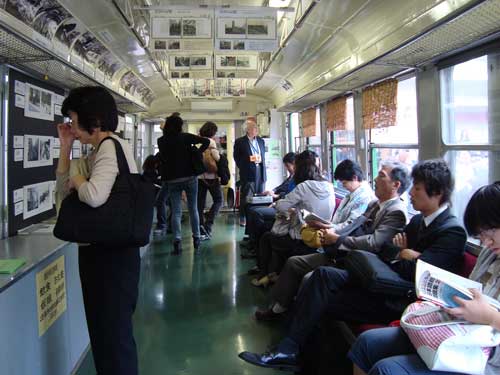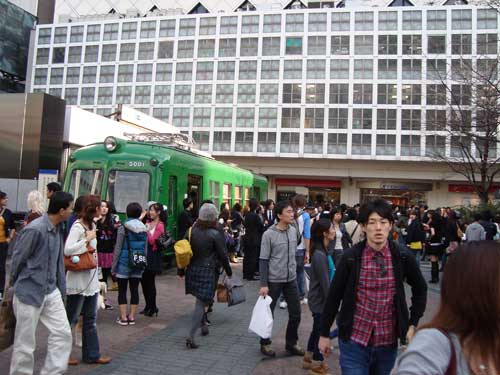
三浦海岸は東京湾の下の方にあります。東京から電車で行きやすいです。夏の涼しいスポットです。
Miura Kaigan is at the bottom of Tokyo Bay, and easily reachable by train from Shinagawa. Another cool spot to relax during the heat of summer.

三浦海岸は東京湾の下の方にあります。東京から電車で行きやすいです。夏の涼しいスポットです。
Miura Kaigan is at the bottom of Tokyo Bay, and easily reachable by train from Shinagawa. Another cool spot to relax during the heat of summer.

渋谷で写真撮影をしました。タヌキが渋谷川から東京に入ってきます。東急グループの新しいヒカリエを訪れて、渋谷駅のDean & Delucca でコーヒーを飲みます。そして、サラリーマンに健康的な息抜きと逃避の方法を教えています。
Tanukis are real and mythic animals that once inhabited Tokyo, and are now primarily found as large ceramic statues outside local bars and restaurants. Tanukis are shape shifters, with a special superpower emanating from their floor-scraping scrotums.
My Tokyo Local Fruit co-instigators, Chris Berthelsen (of A Small Lab) and Jess Mantell (of Edoble), and I have been thinking about this subject through a contest submission for Animal Architecture and related articles to be published online soon. We’re calling our new research effort, the Studio for Creative Revitalization of Tanuki Urban Manifestations, or S.C.R.O.T.U.M.
We would like to encourage more urban human/non-human cohabitation, and are inspired by what a tanuki-friendly Tokyo would look and feel like. Here are some images from a recent photo shoot in Shibuya. Jess will add to the images to suggest new scenarios of interaction and play.
You could imagine tanuki entering the big city by river, and then interacting with the human inhabitants.
Tanuki visits Tokyu Corporation’s new Hikarie shopping complex, has a coffee at the Dean and Delucca outside Shibuya station, and encourages office workers to find healthier ways to relax and escape.




都市計画が良くないのに、東京生活は素晴らしいと友達に話します。最近、TEDxSeedsに行って、横浜の港でまた遊びました。大さん橋という国際埠頭はきれいな建築や商売や水辺公園を組み合わせています。横浜がこんな新しい開いたスペースを作られるならば、東京もできるはずです。
I often tell people that Tokyo’s urban life is wonderful in spite of city planning. On the one hand, this view valorizes the activities of everyday people in making public spaces alive with plants, care, and community. On the other hand, it also expresses a resignation that city leaders cannot or will not improve city life.
Recently I attended TEDxSeeds at Yokohama’s restored port. In addition to wonderful historic buildings that are preserved and reused, the entire port area has a revitalized public park and waterfront promenade. One of the most spectacular public places is the undulating rooftop park above the International Ferry Terminal, designed by London’s Foreign Office Architects; in Japanese it’s called Osanbashi.
This is a bold example of creating a new open space that combines commerce (the business of loading and unloading passenger ships) with a place for residents and visitors to stroll and relax on the waterfront. I heard one Yokohama resident refer to the building as “the whale” building because of its curvy surface.
If Tokyo city leaders thought big, what kind of new public spaces could be created here? How could some of its past be made visible and accessible today? What natural resources could be reclaimed with great architecture and some vision? It seems in terms of city planning that Japan’s other cities are more dynamic and more forward-looking than its capital.


Tokyo’s great transit system allows you to go many places without a car. You can enjoy the scenery and meeting many people.
電車がたくさんあるので、車なしでいろいろな所へ行けます。多くの人に会えるし、きれいな景色を楽しめます。
The days are getting shorter, and with clearer skies the sunsets are remarkable. Recently I have been enjoying the views from elevated trains and stations. Trains in Japan are always punctual, clean and efficient. And apart from peak commute times, you can relax and enjoy the peacefulness of leaving the driving to others. Tokyo’s superior urban transportation system allows for a city where private cars are not the main form of mobility. It is still surprising to me how much walking, biking, conversation, playing, and reading dominates Tokyo’s many small streets, with the occasional car slowing down to pedestrians’ pace.


Tokyo is full of empty lots that mark the time between demolition and building. Sometimes they stay empty for more than a year. Most are turned into automated parking lots, some so small they only provide space for a single car. Some in busier neighborhoods get covered in gravel and host crepe shops in a trailer.
The empty lot above, just off Omotesando in Aoyama has three uses: tapioca drinks for sale, vending machines, and ashtrays for smokers. Considering the proximity to so much high-end shopping and so many people, it seems like a vastly under-utilized urban space.
It would be cool to see something more useful in these temporary spaces: energy generators, plants for shade and habitat, edible gardens, nurseries to grow and sell plants, attractive places for relaxation, socializing, and pets. Their design would need to be portable, modular, and generate some minimal income for the owner. Creating a prototype space for these liminal spaces would be a great project for a local government, corporation, or non-traditional marketing company.

An interesting article about Apple’s new prototype store in Palo Alto, the center of Silicon Valley. It will have a transparent glass facade and trees growing inside. According to the developer, “the store is a commons for the applicant’s community to gather.” Apple is a global trend leader in retail space.
I like the “commons” image of cutting edge retail space as a community space, and the design concept that trees will make people feel more relaxed, more likely to linger, and more ready to learn. The architect is Bohlin Cywinski Jackson, who designed NYC’s Fifth Avenue store, seen above. Maybe the trees will be apple trees?

Just outside Shibuya station, next to the famous Hachiko statue, is a single train with wonderful photographs of how the station area has evolved in the past hundred years. What amazes me is that in crowded Tokyo, a museum train prompts most visitors to relax and behave as if they were in a real train. Apart from one woman studying the exhibit and one man representing the exhibit, the other “passengers” are acting like typical Tokyo train riders: two salary men sleeping, two people reading books, and a couple talking with eachother. Below gives you an idea of the context of this non-moving, perhaps hyper-real experience.
